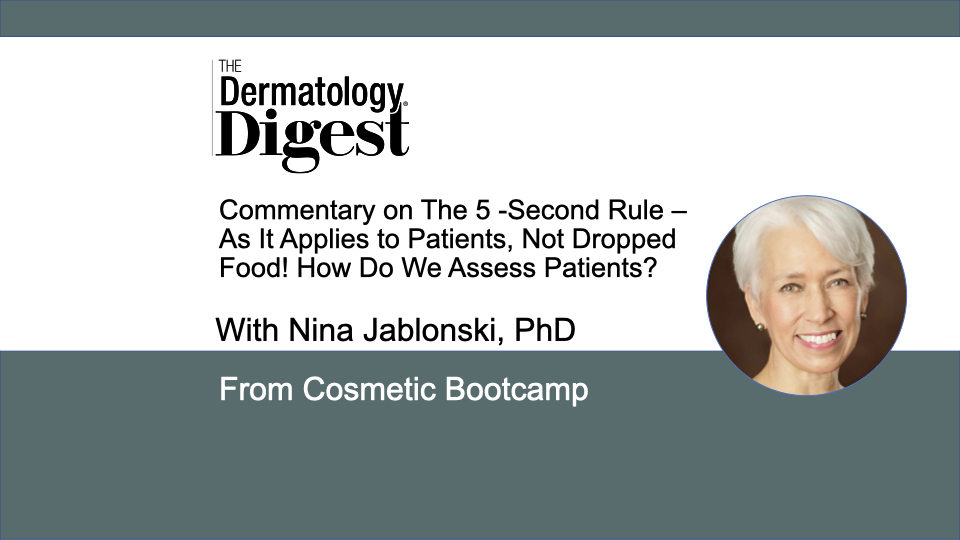Dr. Nina Jablonski discusses key messages from a recent panel discussion on how dermatologists and other physicians who have aesthetic practices can improve and optimize their patient interactions and assessments.
Nina Jablonski, PhD, Evan Pugh University Professor of Anthropology, Pennsylvania State University, University Park, Pennsylvania. Dr. Jablonski’s research focuses the evolution of skin and skin pigmentation and what it means to people’s health, social wellbeing and their concepts of themselves.
“This session was really all about how can a physician—whether a dermatologist, a cosmetic plastic surgeon, or oculoplastic surgeon concerned broadly with human appearance—treat patients well and fairly?” said Nina Jablonski, PhD, who moderated the discussion “The 5 -Second Rule—As It Applies to Patients, Not Dropped Food! How Do We Assess Patients?” at the Cosmetic Bootcamp Summer Meeting 2023 in Aspen, Colorado.
Mary Lupo, MD, a dermatologist from New Orleans and Cosmetic Bootcamp co-founder; Rod Rohrich, MD, a cosmetic plastic surgeon from Dallas; and José Montes, MD, a Cosmetic Bootcamp co-organizer and oculoplastic surgeon from San Juan, Puerto Rico, participated on the panel, according to Dr. Jablonski.
“All three have very successful practices and have been doing this for a long time. They all recognized how important it is for physicians to be open-minded, well-rested, and really ‘up’ in terms of the information they have about their patients.”
The 5-second rule is important because impressions form quickly, said Dr. Jablonski.
“To be able to show in your own face a willingness to engage, a gentle authority, and a positive human engagement through an honest smile and eye-to-eye contact, you will have made a direct conduit for exchanging information with your patient. And it will be a great place to start the interaction.”
It begins by going into the patient interaction prepared and that means reading the their history and any other available background information, said Dr. Jablonski.
“But also, go in as a person. Go in as a person who is going to engage eye-to-eye, at the same physical level as the patient. Go in with an open mind, to ask honest questions about what a patient wants and why.”
Check Biases at the Door
Physicians should recognize that they and other health care professionals suffer from the same kinds of biases as the general population, said Dr. Jablonski.
“Even though we might think we do not have biases about race, gender affiliation, age, presence, or absence of tattoos, any number of things, it’s really important to be aware of those and check those at the door … to the greatest extent possible.”
Elements of Engagement
The panelists reiterated the importance of engagement, asking clear questions, and putting patients at ease by showing genuine interest in their impressions of themselves and what they want to have done.
It’s important to ask patients about their goals from procedures, how they want to appear post procedure, and why, said Dr. Jablonski.
“All the panelists emphasized the importance of the physician taking gentle control of the situation, having a presence, being confident but not overly assertive. [This means] projecting a willingness to engage while recognizing they are the ones who have the expert knowledge.”
All presenters echoed the importance of eye-to-eye engagement, direct engagement, and careful listening, said Dr. Jablonski.
“Last but not least, [we discussed] the importance of being well-rested or at least not having a lot of stressful interactions having preceded your engagement with the patient. We know from a cognitive science perspective that if you have stressors in the office or if you’ve had a difficult patient right ahead of the patient you’re going to see, that you may be preloaded with some level of negativity.”
Try to clear those buffers, she said. One way to keep the office as stress-free as possible is to pace your patient load, so you have a manageable schedule and will be as open-minded and clear a listener as possible when entering patient rooms.
“That’s so you will hear the nuances of what your patient is saying. Similarly, when you are in a relatively unstressed state, you will be able to present your own information factually and with that strong but gentle presence that is so important to a successful interaction.”


